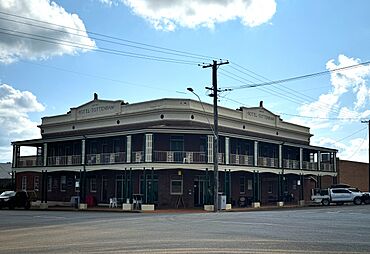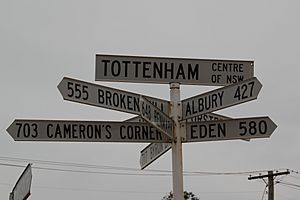Tottenham, New South Wales facts for kids
Quick facts for kids TottenhamNew South Wales |
|||||||||
|---|---|---|---|---|---|---|---|---|---|

Tottenham Hotel, built in 1931
|
|||||||||
| Population | 263 (2021 census) | ||||||||
| Postcode(s) | 2873 | ||||||||
| Location |
|
||||||||
| LGA(s) | Lachlan Shire | ||||||||
| County | Kennedy County, Beaconsfield Parish, New South Wales | ||||||||
| State electorate(s) | Barwon | ||||||||
| Federal Division(s) | Parkes | ||||||||
|
|||||||||
Tottenham is a small town in New South Wales, Australia. It is located in the Central West region. Tottenham is known as “The Soul of the Centre”. This is because it is the closest town to the geographical center of New South Wales. In 2021, about 263 people lived there.
Contents
Tottenham's History
The town of Tottenham got its own post office in 1907. A railway line from Bogan Gate reached Tottenham in 1916. This helped the town grow.
There was a lot of copper mining in the area. This happened between 1903 and the late 1920s. The railway line even went further than Tottenham. It reached the places where copper was melted down, called smelters. There was also a special track to the Caroline Mine.
Where is Tottenham?
Tottenham is in an area where a lot of wheat is grown. There is a special stone marker, called a cairn, that shows the center of New South Wales. This marker is about 33 kilometers (20 miles) west-north-west of Tottenham.
Every year in September, a special event happens near Tottenham. It's called the Far Cairn Rally. This rally is for people who ride touring motorcycles. The name "Far Cairn" is a fun way to say the cairn is far from Sydney. The BMW Touring Club of New South Wales organizes this event.
Tottenham's Achievements
In 2012, Tottenham was chosen as the Most Outstanding Community in New South Wales and the ACT. This was a big award for such a small town! It won in a competition for towns with 15,000 people or less.
Improving the Airstrip
The people of Tottenham worked hard to improve their local airstrip. They made the runway surface smooth and added fences to keep kangaroos out. They also put in lights so planes could land at night. Half of the money for these improvements came from private donations.
Locals were very keen on this project. This was after the Royal Flying Doctor Service could not land there for a medical emergency. This incident involved an important person in the community.
Medical and Other Services
The town also managed to find its own doctor. This was a big deal because the Health Department had said no suitable doctor could be found. Five local people even volunteered to become ambulance officers. They help the two full-time paramedics in the town.
Finally, the town built a large sports center. They worked with the local Shire (council) to share the costs. All these projects in one year helped Tottenham win the Community of the Year award for New South Wales.
Tottenham's Climate
Because Tottenham is near the center of New South Wales, its weather changes a lot between seasons. Summers are long and hot. Winters are cool. The town does not get much rain throughout the year. Most of the rain comes from big thunderstorms or from clouds that come from the northwest.
It has snowed in the area twice that we know of. Snow fell on July 5, 1900. It also snowed sometime in 1874. Both times, the snow fell on the Melrose Plains, which are to the south-west of Tottenham.
| Climate data for Tullamore (Kitchener St, 1970–1988, rainfall 1914–2024); 244 m AMSL; 32.63° S, 147.57° E | |||||||||||||
|---|---|---|---|---|---|---|---|---|---|---|---|---|---|
| Month | Jan | Feb | Mar | Apr | May | Jun | Jul | Aug | Sep | Oct | Nov | Dec | Year |
| Record high °C (°F) | 45.3 (113.5) |
42.7 (108.9) |
39.0 (102.2) |
36.3 (97.3) |
28.5 (83.3) |
26.3 (79.3) |
24.0 (75.2) |
28.5 (83.3) |
35.7 (96.3) |
37.0 (98.6) |
43.1 (109.6) |
42.0 (107.6) |
45.3 (113.5) |
| Mean daily maximum °C (°F) | 33.1 (91.6) |
32.4 (90.3) |
29.5 (85.1) |
24.7 (76.5) |
19.9 (67.8) |
16.1 (61.0) |
15.3 (59.5) |
17.2 (63.0) |
20.5 (68.9) |
24.6 (76.3) |
28.4 (83.1) |
32.2 (90.0) |
24.5 (76.1) |
| Mean daily minimum °C (°F) | 17.8 (64.0) |
17.9 (64.2) |
14.4 (57.9) |
10.1 (50.2) |
6.6 (43.9) |
3.2 (37.8) |
2.4 (36.3) |
3.4 (38.1) |
5.8 (42.4) |
9.6 (49.3) |
12.6 (54.7) |
15.7 (60.3) |
10.0 (49.9) |
| Record low °C (°F) | 8.1 (46.6) |
7.5 (45.5) |
4.5 (40.1) |
−2.0 (28.4) |
−3.5 (25.7) |
−3.7 (25.3) |
−5.6 (21.9) |
−3.0 (26.6) |
−2.2 (28.0) |
0.8 (33.4) |
1.5 (34.7) |
5.5 (41.9) |
−5.6 (21.9) |
| Average precipitation mm (inches) | 52.6 (2.07) |
46.9 (1.85) |
42.6 (1.68) |
37.6 (1.48) |
38.1 (1.50) |
38.4 (1.51) |
35.5 (1.40) |
37.6 (1.48) |
33.0 (1.30) |
43.7 (1.72) |
46.4 (1.83) |
45.1 (1.78) |
497.4 (19.58) |
| Average precipitation days (≥ 0.2 mm) | 5.1 | 4.7 | 4.4 | 4.3 | 5.5 | 6.5 | 6.7 | 6.4 | 5.3 | 6.2 | 5.5 | 5.0 | 65.6 |
| Source: Australian Bureau of Meteorology; Tullamore (Kitchener St) | |||||||||||||



